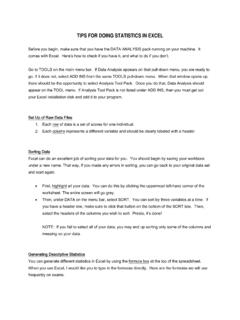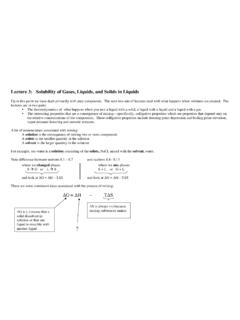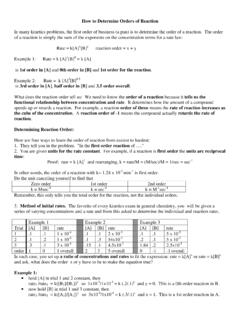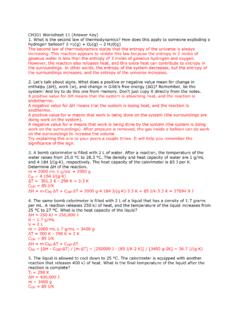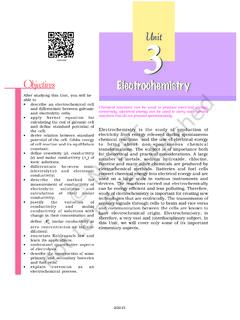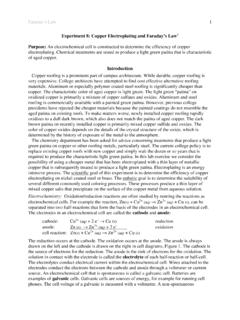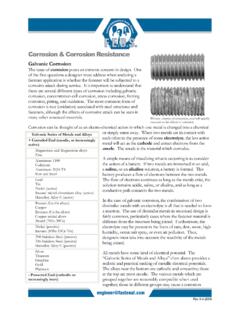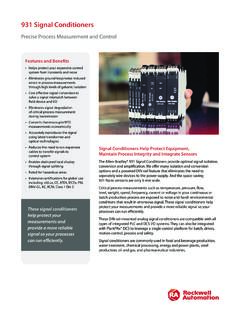Transcription of Chapter 21: ELECTROCHEMISTRY TYING IT ALL TOGETHER
1 1 Chapter 21: ELECTROCHEMISTRYTYING IT ALL TOGETHER -RT ln K=G =-nFEoCH 17-20 =CH15 = CH 212 Important errata to = x 104 C/mole in problem on current of section on anodes and cathodes should read: Oh, and byconvention, in a galvanic cell the positive terminal is the CATHODE andthe negative terminal is the ANODE 3As we move into our final section of the course, we tackleelectrochemistry which is our first real example of modern analyticalchemistry. By that we mean that plenty of scientists do electrochemistrytoday because it is often the best way to solve certain problems inchemical analysis like understanding corrosion (rust).
2 4 ELECTROCHEMISTRY is is also important to technological advances in societybecause it has everything to do with creating effective forms of solarheating, making electric cars work and generally doing anything usefulthat involves energy storage. So the next time the rechargeable battery onyour lap top computer or your camcorder or your boom box reachesequilibrium (dies), stop to think about how extraordinary theelectrochemistry was that made such a battery in the first is physical measureof electron movement in chemical looking for a context for understanding ELECTROCHEMISTRY , recognize thatall of chemistry centers around the making and breaking of chemicalbonds.
3 Chemical bonds are formed by a redistribution of electron densityaround nuclei. ELECTROCHEMISTRY has as its foundation the well-controlleddelivery or measure of a source of electrons; , the number of electronsdelivered or produced and the work it takes to move the electrons is wellknown. Note that there will be many parallels between electrochemistryand acid/base chemistry. The primary distinction is the difference incurrency, we now care about electrons rather than protons, but we usuallyask the same H+ e-6 Ten things to know before working ELECTROCHEMISTRY problems:1.
4 Oxidation-Reduction Reactions. Every electrochemical reaction mustinvolve a chemical system in which at least one species is being oxidizedand one species is being reduced. For exampleFe+3 Cu+Fe+2Cu+2 oxidizing agentreducing agent reduction productoxidation productIn this case, as noted, there is an oxidizing agent that accepts electrons toform a reduction product (the Fe+++/Fe++ couple here) and a reducing agentthat donates electrons to yield an oxidation product (the Cu+/Cu++ couple).Please review of time you evaluate the ELECTROCHEMISTRY of a system, identify thehalf reactions and where and what the electrons are out for a kind of problem you are expected to do on the exam:Determining relative strengths of oxidizing and reducing agents.
5 Inworking this kind of problem, note the similarities to relative acid/basestrength problems. In both cases you start with a list of reactions:acid and base strengthoxidizing and reducing agentstrengthKa acid dissociation rxnKbEoredreduction half rxnEoox10-2 HSO4- H+ + SO4= ++ + 2e- Zn+ H+ + + + 2e- + H+ + NH310-5+ ++ + 2e- is the strongest acid, NH3the strongest baseCu++ is strongest , Zn isstrongest red. agent8 Things to notice in comparing K to E for relative strengths: The are two directions for reactions: acids in the forward direction,bases in the reverse direction; reduction in the forward direction,oxidation in the reverse direction.
6 There are two pairs of constants, Ka and Kb, Ered and Eoxid. There are some simple rules for determining strength:"The larger the Ka, the stronger the acid and the weaker the conjugate base""The larger the Kb, the stronger the base and the weaker the conjugate acid.""The stronger the oxidizing agent the more easily a species is reduced""The stronger the reducing agent, the more easily a species is oxidized." In table as written, the strongest acid is always in the upper left handcorner (HSO4-) and the strongest base in the lower right hand corner(NH3).
7 The strongest oxidizing agent (most easily reduced) is alwaysin the lower left hand corner (Cu++) and the strongest reducing agent isin the upper right hand corner (Zn).92. ELECTROCHEMISTRY is not done at equilibrium. As we will learn, whenyou are at equilibrium, you have a dead battery ( G = 0)--and nothing getsdone with a dead battery. So most ELECTROCHEMISTRY is done by monitoringthe flow (direction and amount) of electrons as a non-equilibrium systemmoves toward Physics that you should know:a. Electrical Charge. The fundamental unit of charge, q, is measured inCoulombs.
8 One electron has a charge of x 10-19 Coulombs (C).Therefore, one mole of electrons has a special amount of chargeF= Faraday (Coulombs/mole) = q (Coulombs) / n (moles)F = x 104 C/moleSo electrons are our currency for electrochemical measurements in thesame way that protons were our currency for acid/base reactions. AFaraday is simply an amount of charge in the same way a dozen is anamount of : In a redox reaction involving the reduction of Fe+++ to Fe++, atotal of 9649 x 103 C are used up. How much Fe+++ was reduced?
9 1mole Fe+3 ( x 103C)( )( ) = Fe+3 x 104C/mol 1mole FeNote that for this reaction, a single electron is transferred from the Cu+ tothe Fe+++. This is analogous to a single H+ transfer in a monoprotic Add time to the equation and get CURRENT. The measure of current as a function of time is the ampere:One Ampere = one Coulomb/secondHaving current measured as a function of time means we can talk about arate of reaction (kinetics stuff, something we haven t considered since westarted equilibrium.)13 Example: What is the current measured in a circuit involving the half cellreactionSn+4 + 2e- Sn+2which is occurring at a rate of x 10-3 mole/hr?
10 1hr2 mole e- x 104Ci = ( x 10-3mole/hr) ( )( )( ) = 3600s1 mole Sn+4 moleBy the way, what do you think about this magnitude of current? Will itkill you? Will it power a small city or a small toy?14c. What about the WORK necessary to move electrons? In ELECTROCHEMISTRY this is electric POTENTIAL, E, measured in Volts(V). E is the measure of the potential difference between two points. It isthe physical measure of work that is done when one Coulomb of chargepasses between two points. Work has the units of Joules, and with V andC also mks units, we have thenWork (J) = q E = (volts)(Coulombs)So one Joule of work is done when one Coulomb moves across a potentialgradient of one don't blow this off, w = qE is an extremely important concept in anykind of science associated with moving charged How much work does it take to move over x 10-3 moles ofelectrons across a V potential?
